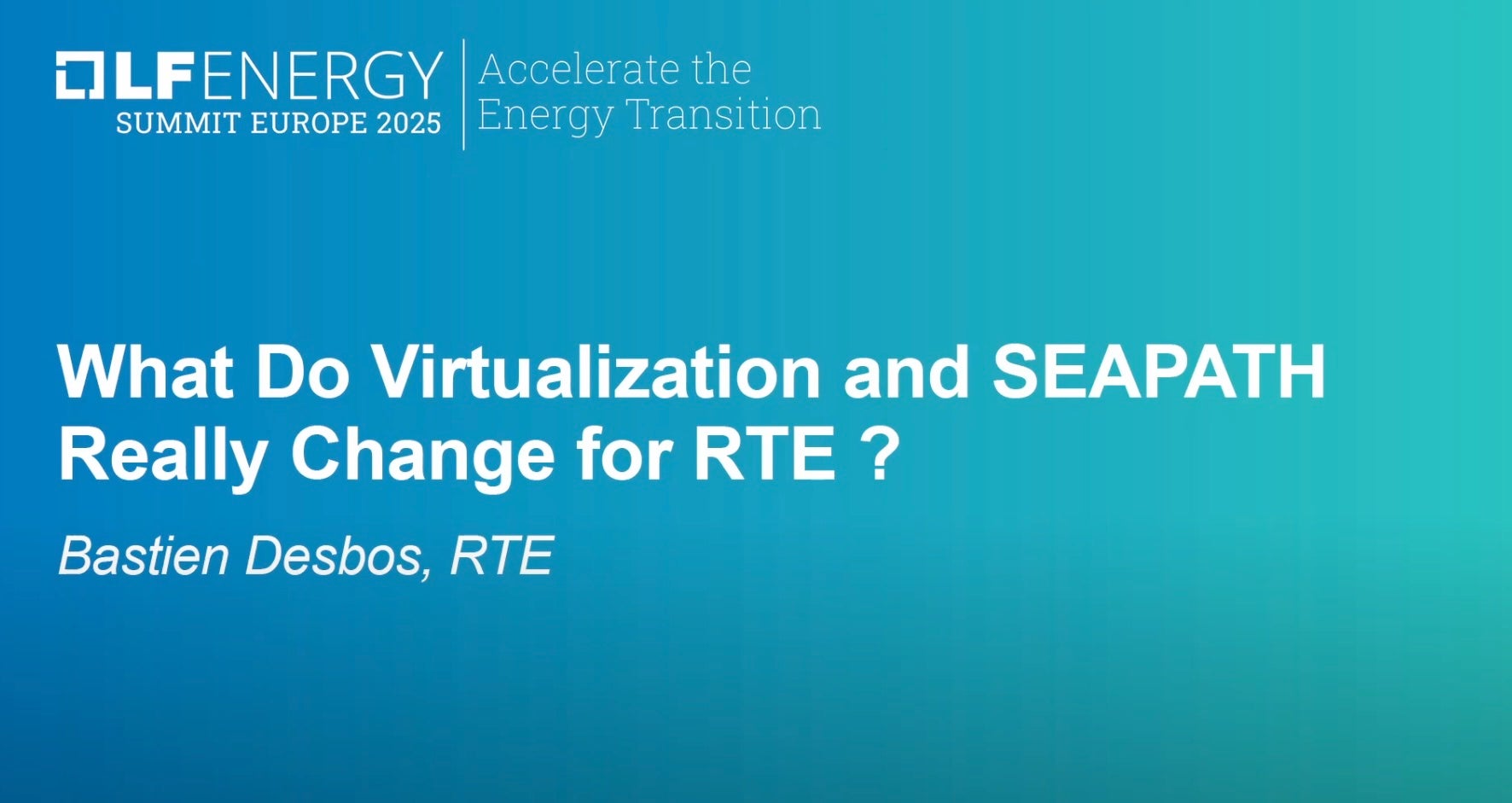Reimagining Substation Infrastructure: How Virtualization and SEAPATH Are Transforming RTE’s Energy Systems
At the 2025 LF Energy Summit, Bastien Desbos, Project Manager at RTE, outlined how France’s national transmission operator is pioneering digital transformation of substation infrastructure through open source virtualization technologies: SEAPATH and VIPeR.
The transformation moves RTE from proprietary, monolithic PACS systems to modular, interoperable open source architectures, unlocking flexibility, resilience, and transparency across the grid.
From Monolithic to Modular: RTE’s Strategic Shift
- Historically, RTE procured PACS (Protection, Automation, and Control Systems) as turnkey, vertically integrated, proprietary solutions from four vendors.
- These systems created rigid architectures with high costs and little flexibility over their 25-year lifespans.
- To address this, RTE pivoted to build a single interoperable architecture that:
- Supports multiple vendors (hardware + software)
- Relies on open standards like IEC 61850
- Leverages virtualization and internal integration
Why Virtualization? Why SEAPATH?
- SEAPATH, a Linux Foundation Energy project, forms the open source virtualization backbone for RTE.
- Built using:
- Debian-based stack
- KVM (Kernel-based Virtual Machine) for virtualization
- Ansible for automation
- Hosted on clusters of three servers
Key benefits:
- Reduced hardware footprint via virtual machines (VMs)
- Flexibility in updating and managing software
- Transparency through open source components
- High availability using failover within the cluster
Real-World Applications: From HMI to Circuit Breaker Automation
SEAPATH is already deployed in multiple RTE substations, powering virtualized functions like:
- Local HMI (Human-Machine Interface) for on-site control
- Gateway/RTU (Remote Terminal Units) for communication translation
- Automation systems (e.g., circuit breaker failure recovery)
- FTP services for fault recording
- Configuration tools for IEDs and network devices
Resilience:
If one server fails, VMs automatically restart on another, ensuring continuity and reliability.
What’s Next: Virtualized Protection Functions
- Next milestone: virtualizing protection functions that detect grid faults and trigger circuit breaker actions.
- RTE has launched tenders with vendors (e.g., ABB) to supply protection algorithms as VMs.
- Early tests show strong promise.
- RTE’s aim: encourage open, interoperable protection software, not internalize development.
Addressing the Challenges
Virtualization introduces new operational challenges:
- Integration complexity requiring management of multi-source components
- Potential software-level lock-in via proprietary VMs
- Maintenance evolution due to shorter hardware lifespans and more frequent software updates
RTE’s response:
Investing in process redesign and organizational change to manage the entire technology stack effectively.
Future Possibilities: AI, Fault Prediction, and Full Digitization
Looking ahead, RTE is exploring:
- AI-driven fault prediction
- Advanced monitoring tools for optimization
- Expanded virtualization across more grid functions
The roadmap remains open and collaborative, focusing on where virtualization adds the most value.
A Collaborative Path Forward
Bastien Desbos highlighted open source collaboration as the key to progress.
SEAPATH enables cooperation among hardware vendors, software developers, and utilities, shifting substation design from vendor-bound silos to flexible, interoperable ecosystems.
“What SEAPATH enables is not just a new technical capability. It is a cultural shift toward transparency, choice, and innovation.”
About SEAPATH
SEAPATH (Software Enabled Automation Platform and Artifacts), hosted by LF Energy, delivers a reference design and implementation for real-time, virtualized substation platforms.
If your organization is exploring infrastructure modernization, RTE’s example illustrates what’s possible when virtualization and open source align.
🔗 Learn more: https://lfenergy.org/projects/seapath
Watch the presentation: What Do Virtualization and SEAPATH Really Change for RTE ? – Bastien Desbos, RTE
FAQ
Q1: What is SEAPATH?
A Linux Foundation Energy project providing a real-time, open source virtualization platform for digital substations.
Q2: Who is RTE?
Réseau de Transport d’Électricité (RTE) is France’s national electricity transmission operator.
Q3: What is VIPeR?
RTE’s internal initiative complementing SEAPATH to virtualize and modernize PACS systems.
Q4: Which technologies underpin SEAPATH?
Debian, KVM (Kernel-based Virtual Machine), and Ansible for deployment automation.
Q5: What is the next milestone for RTE?
Virtualizing protection functions, critical components for grid fault detection and safety.
Keyword Cluster
SEAPATH, RTE, LF Energy, Virtualization, Substation Automation, IEC 61850, Open Source Grid, PACS Systems, Digital Energy Infrastructure, Linux Foundation Projects
About LF Energy
LF Energy, part of the Linux Foundation, accelerates the energy sector’s digital transformation through open source collaboration, fostering interoperability, innovation, and sustainable grid modernization.
🔗 Visit LF Energy
Last updated: October 9, 2025
